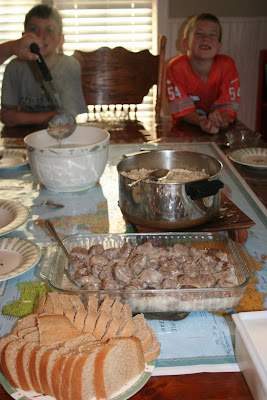Yesterday, we spent the afternoon and the better part of the evening collecting the honey from our hardworking bees. It was a messy, sticky job, but mmmm-mmmm, the results were worth the work. After Paul snatched the 3 extra "supers" (which is a box with 10 frames of wood in it that the bees build their honey combs on) from the bees and brought them into the garage, he cleared any remaining bees off and stacked them in the kitchen. We left 2 "super" boxes on each hive (we have 2 hives so far). One box is for their food supply for the winter and the other is for their brood (little baby bees).

Paul took one frame out at a time and skimmed off the honeycomb's wax tops with a heated knife. Each little comb is filled to the brim with pure delicious honey. Bees are actually very clean, particular animals. They even have their own "garbage dump" in a corner of the hive where they bury any invading insects in an antibacterial, antiviral, and antifungal goop called propolis (which is very useful to humans and I intend to collect it at some point and experiment).

After decapping, he put the frame in Uncle Mike's homemade honey extractor (that's my handy brother-in-law). After positioning 4 of the frames in the extractor, the boys turned the crank and spun the honey out onto the sides of the wooden barrel.
 The honey drips down the sides and collects at the bottom of the barrel and the frame is taken out checked to see if the combs are empty, and the process is repeated on the other side (those hardworking bees build the comb out on both sides of the frame).
The honey drips down the sides and collects at the bottom of the barrel and the frame is taken out checked to see if the combs are empty, and the process is repeated on the other side (those hardworking bees build the comb out on both sides of the frame). After enough honey collects on the bottom, we take the cap off the litte white pipe, and drain the honey into a strainer that sits in the top of a 5 gallon bucket (the strainer collects any extra wax or things that don't belong in the honey).
After enough honey collects on the bottom, we take the cap off the litte white pipe, and drain the honey into a strainer that sits in the top of a 5 gallon bucket (the strainer collects any extra wax or things that don't belong in the honey). The honeycomb caps that Paul cut off got their fair share of use too. The kids got plenty of chances to taste-test the wax caps (which were covered in honey, yum... their favorite part). The rest of the wax was strained (to remove as much honey as would drain), then warmed in a double boiler to melt the wax. Once the wax was melted (but still mixed with the honey that wouldn't strain), we poured it into a bowl to let it harden. The wax will float and harden, and the remaining honey will settle to the bottom. Then we break out the wax, rinse it, and save it for one of our winter experiments.... Candle-making!
The honeycomb caps that Paul cut off got their fair share of use too. The kids got plenty of chances to taste-test the wax caps (which were covered in honey, yum... their favorite part). The rest of the wax was strained (to remove as much honey as would drain), then warmed in a double boiler to melt the wax. Once the wax was melted (but still mixed with the honey that wouldn't strain), we poured it into a bowl to let it harden. The wax will float and harden, and the remaining honey will settle to the bottom. Then we break out the wax, rinse it, and save it for one of our winter experiments.... Candle-making! Then came the clean up... sticky, waxy and messy. I think it took us almost as long to clean up as it did to extract the honey, but there you have it... 6 hours of work for a year's worth of honey and our hands-on homeschool lesson for the week...
Then came the clean up... sticky, waxy and messy. I think it took us almost as long to clean up as it did to extract the honey, but there you have it... 6 hours of work for a year's worth of honey and our hands-on homeschool lesson for the week...

















 Caleb, my "left-hand-man", celebrated his 11th birthday last weekend. That puts him just 2 years away from being an official teenager. Where does the time go. It's amazing how fast they grow. In the last year, Caleb has really started to grow into a young man. I can't believe how strong he is. He carries 50 pound bags of grain around like they're paper weights. Whenever I need something heavy carried (and Paul's not home), I ask Caleb. That boy can actually carry his dad on his back (for a little while)! I call him my "left-hand-man" because, well, I'd be up a creek without him. He's so responsible and helps out soooo much. Many mornings he'll have breakfast cooking by the time I come downstairs (since he wakes at 6am to milk the goats and I am NOT a early riser by nature). He doesn't just make pancakes anymore. Nope, he's expanded to Amish oatmeal, baked apple pancakes, coffee cakes, cinnamon rolls... anything we have a recipe and the ingredients for. It's likehaving a B & B in my own home!
Caleb, my "left-hand-man", celebrated his 11th birthday last weekend. That puts him just 2 years away from being an official teenager. Where does the time go. It's amazing how fast they grow. In the last year, Caleb has really started to grow into a young man. I can't believe how strong he is. He carries 50 pound bags of grain around like they're paper weights. Whenever I need something heavy carried (and Paul's not home), I ask Caleb. That boy can actually carry his dad on his back (for a little while)! I call him my "left-hand-man" because, well, I'd be up a creek without him. He's so responsible and helps out soooo much. Many mornings he'll have breakfast cooking by the time I come downstairs (since he wakes at 6am to milk the goats and I am NOT a early riser by nature). He doesn't just make pancakes anymore. Nope, he's expanded to Amish oatmeal, baked apple pancakes, coffee cakes, cinnamon rolls... anything we have a recipe and the ingredients for. It's likehaving a B & B in my own home! Caleb wanted a baseball field cake for his birthday. I'm a bit ashamed to say that he actually baked his own cake and made the frostings, but I DID do the decorating (although he had to draw it out for me). We make quite the team :)
Caleb wanted a baseball field cake for his birthday. I'm a bit ashamed to say that he actually baked his own cake and made the frostings, but I DID do the decorating (although he had to draw it out for me). We make quite the team :)



 Restoring Honor 8-28-10
Restoring Honor 8-28-10